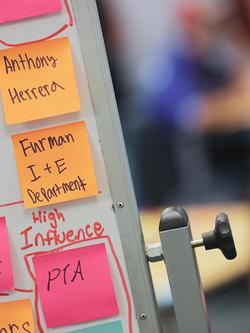MayX Snapshot: Making humans central to the process with design thinking
Each day this week, we’re highlighting a course from May Experience – a chance for students to explore topics beyond the typical academic year.
COURSE: Design Thinking
INSTRUCTOR: Angélica Lozano-Alonso, faculty director of the Institute for Innovation & Entrepreneurship
OBJECTIVE: Using the core steps of the design process, learn how to identify problems, find inspiration for potential solutions, imagine and build prototypes, and implement those new ideas.
Problem 1: How can a nonprofit agency use social media to increase its reach to those in Greenville’s Spanish-speaking population who are survivors of intimate partner abuse?
Problem 2: How can an elementary school teach its students in kindergarten through fifth grade a novel approach to problem-solving?

Adhesive notes on a whiteboard help map out a problem in a MayX class on design thinking.
“External organizations are really excited to work with Furman students,” says instructor Lozano-Alonso. “It’s been really gratifying to see how Furman is so esteemed in our community.”
At the end of this inaugural course, the students presented their “design interventions” to help Safe Harbor maximize its impact on Facebook and to help Summit Drive incorporate design thinking into its curriculum. They used what the instructors call the “Four I’s”: identification of the problems; inspiration from real-world users facing the problems; iteration – repeatedly trying and improving on prototype solutions – and implementation.
Design thinking has become a hot topic lately, with new books appearing constantly and corporations creating their own innovation teams. Misconceptions run rampant, however.
“If you don’t know very much about it, you might think that it’s about creating tangible products, like a mouse or a laptop,” says Lozano-Alonso, a professor of Spanish who also serves as the faculty director of the Institute for Innovation & Entrepreneurship. Instead, innovators are using design thinking to rethink intangible processes such as social entrepreneurship, she says.
The eight students in the class don’t want to learn – they want to do, the instructors say.
“For me, it’s getting them to understand that problems are opportunities, and that they can be agents of change,” says Lozano-Alonso. “I hope it’s just the beginning of them seeing themselves as people who can be problem-solvers in whatever circumstances they find themselves in.”